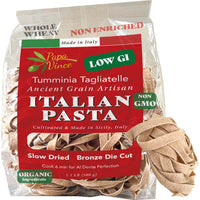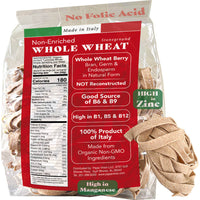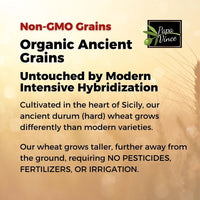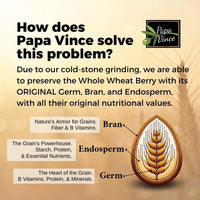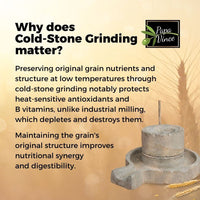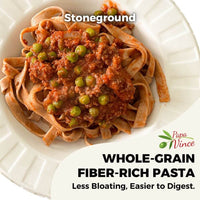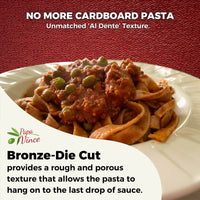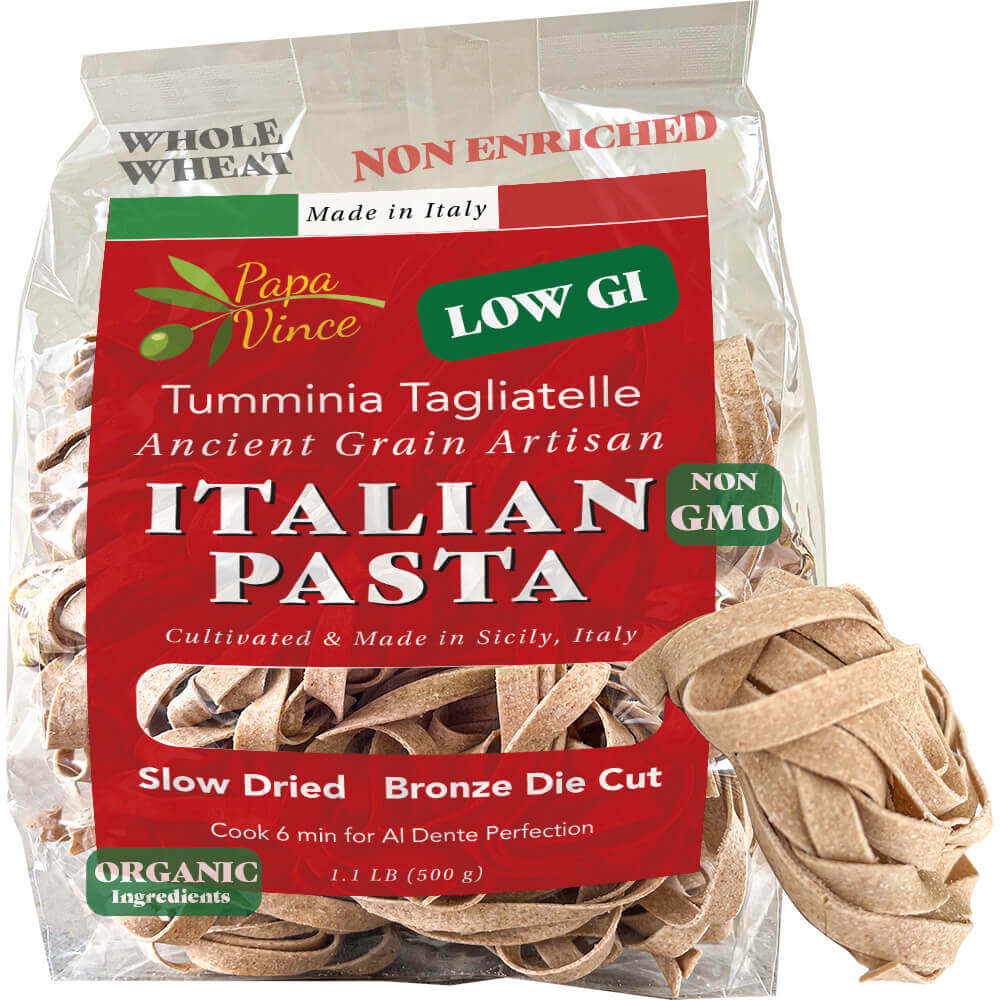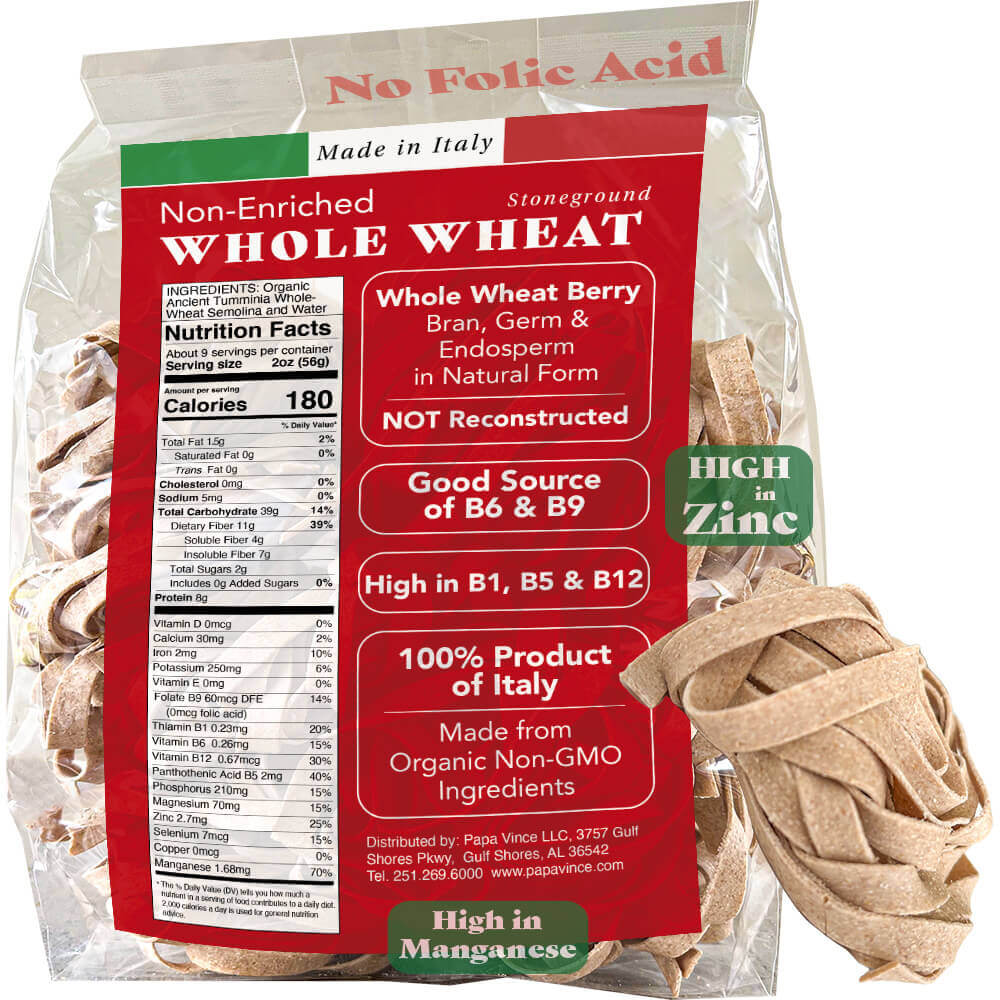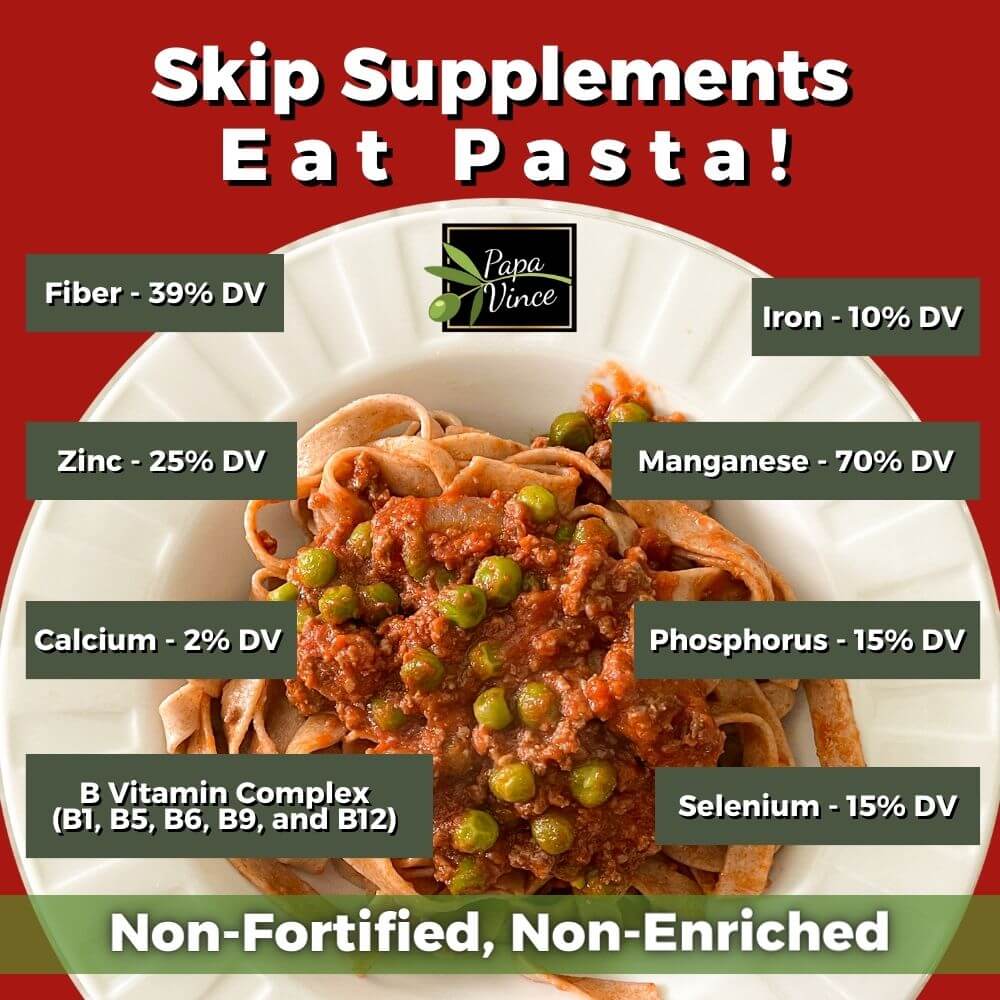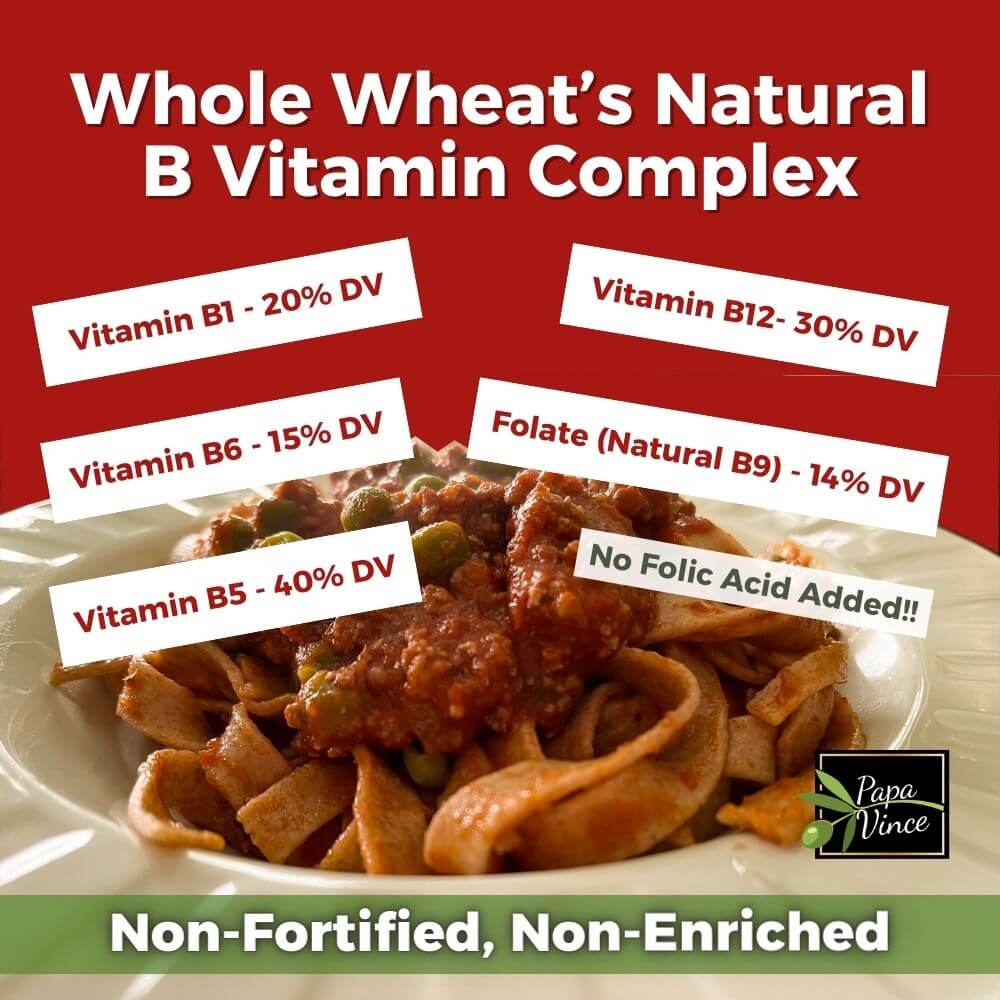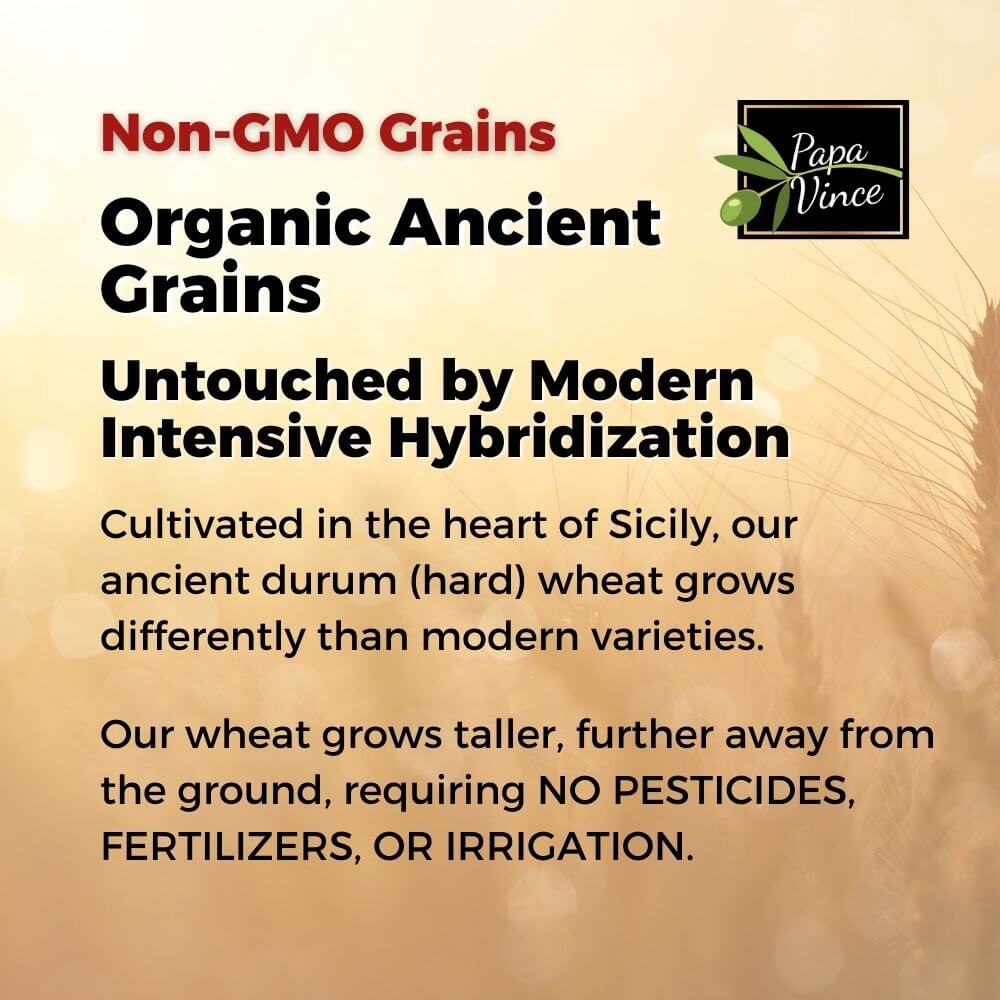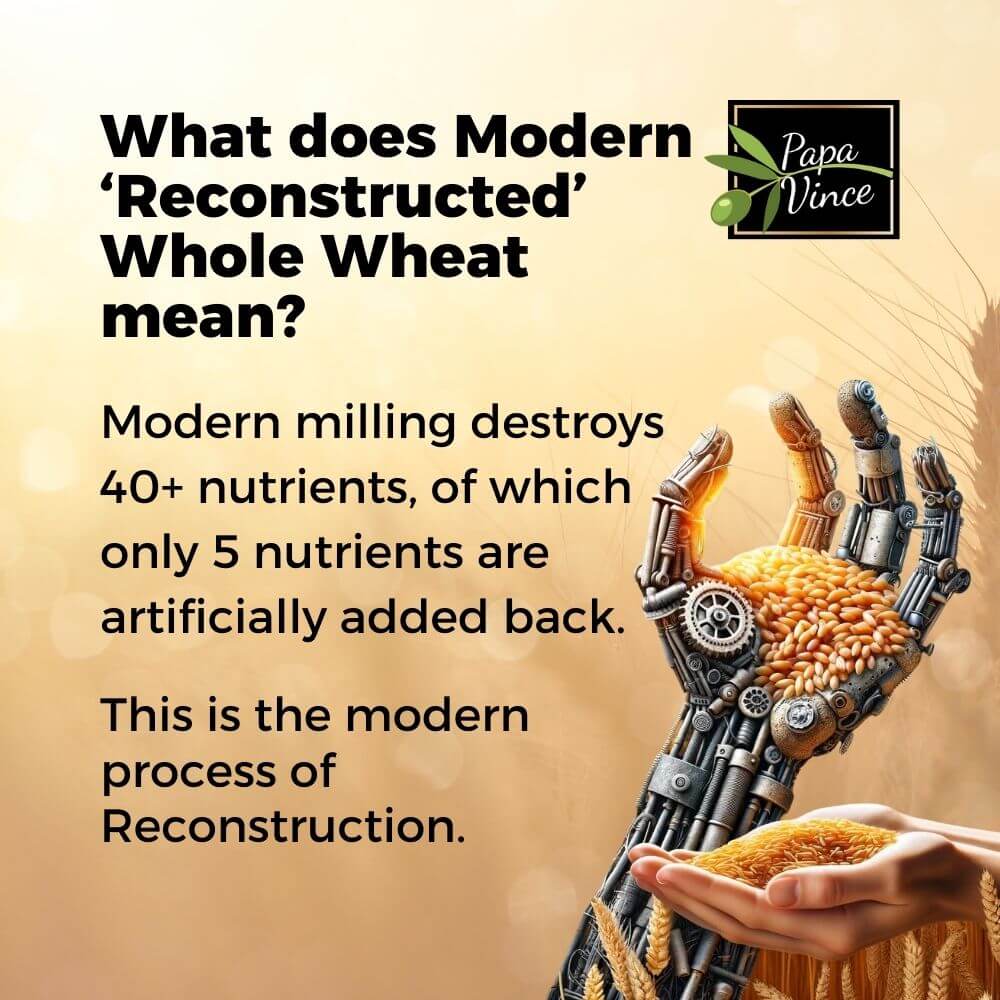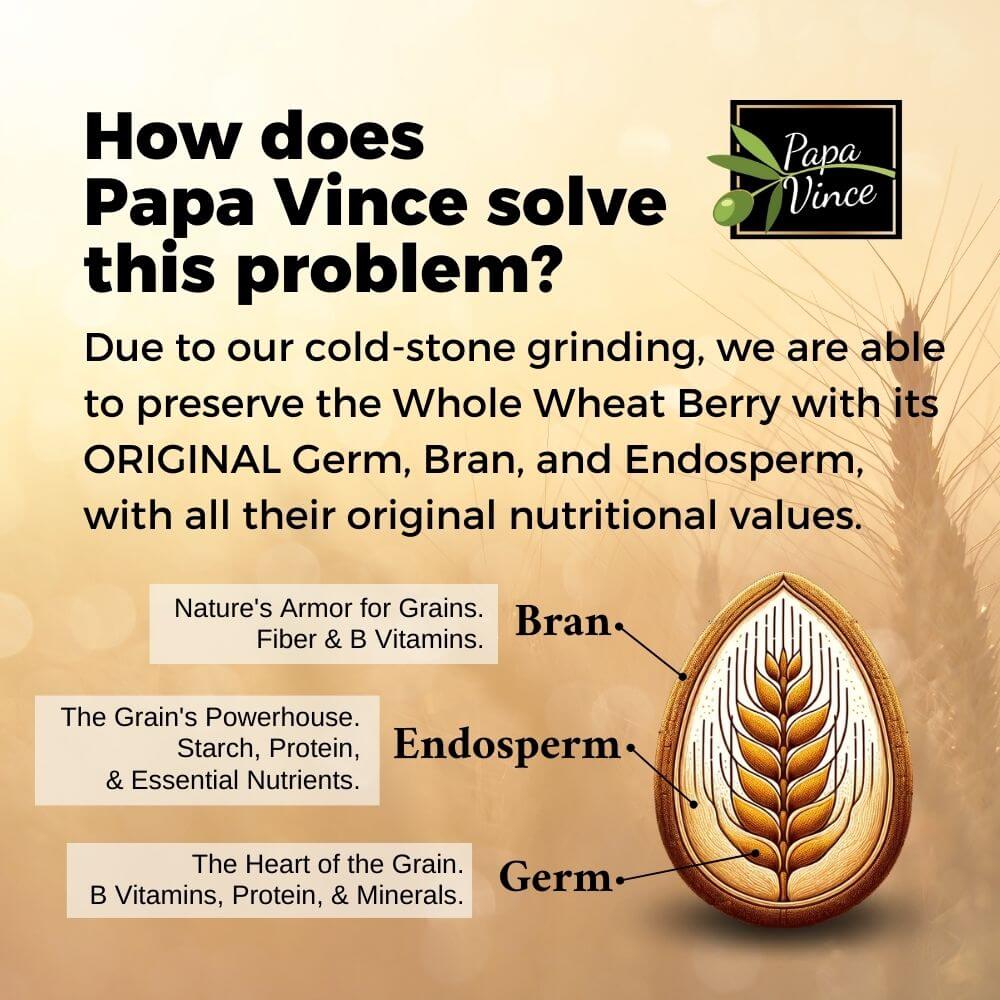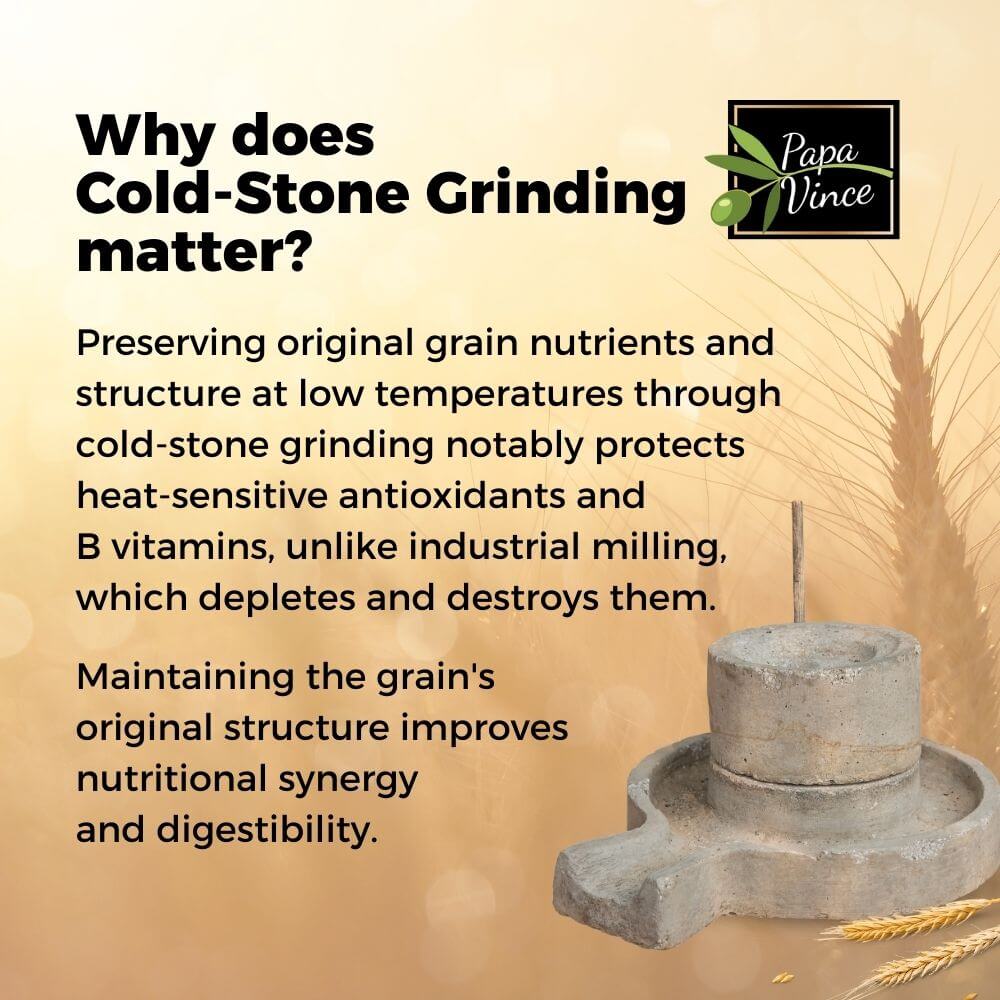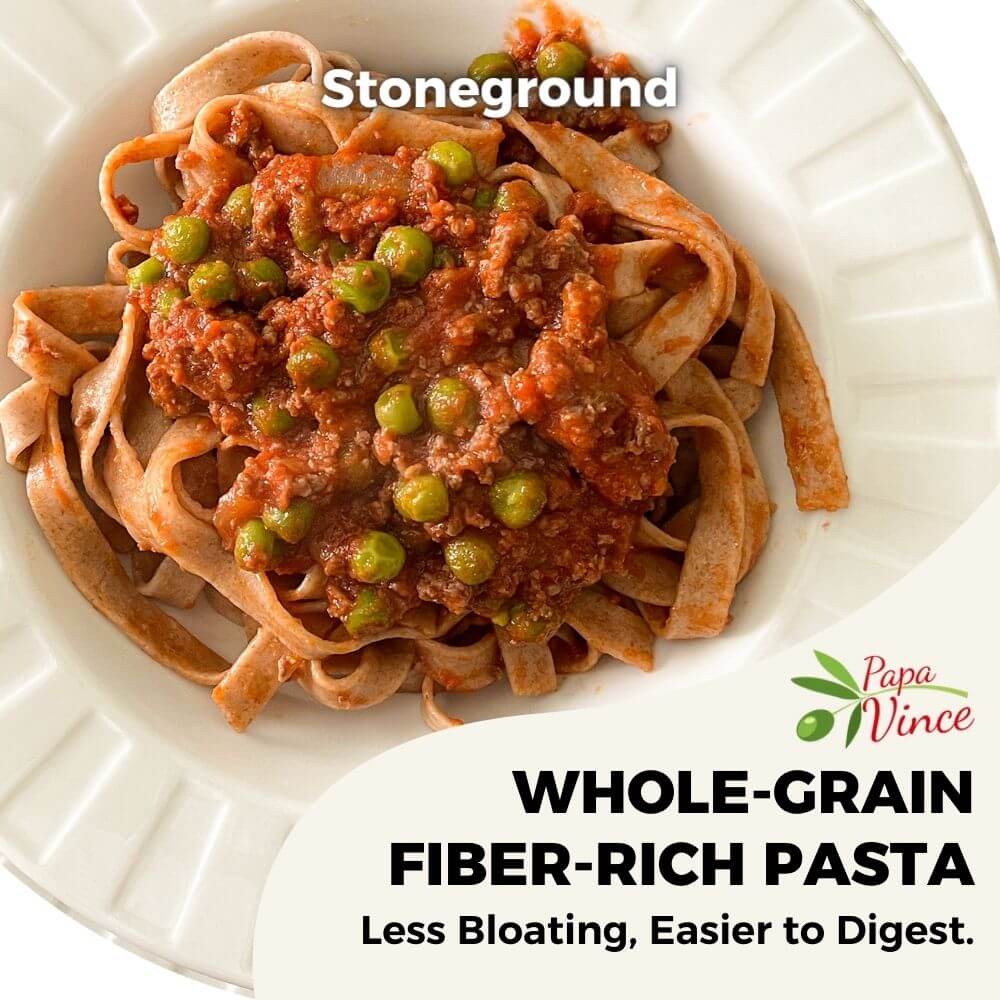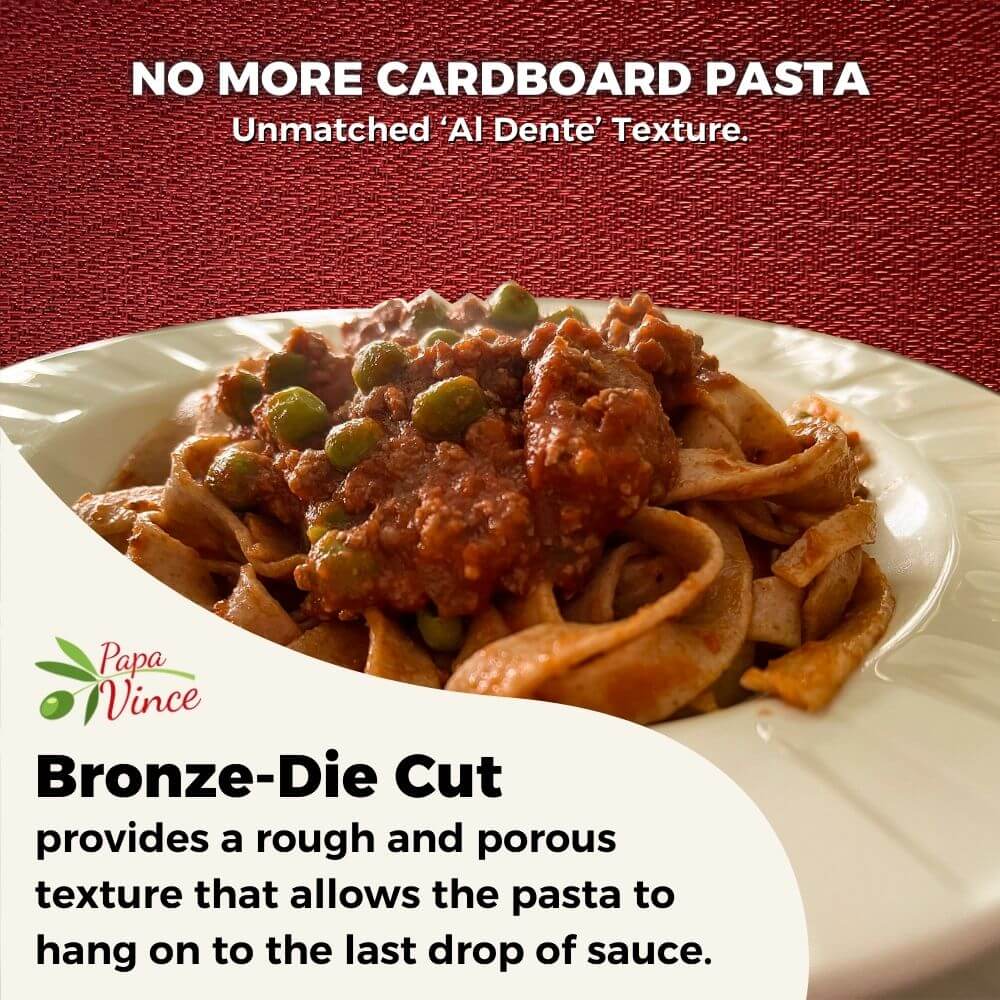Cultivated, Stoneground and Made in Sicily, Italy


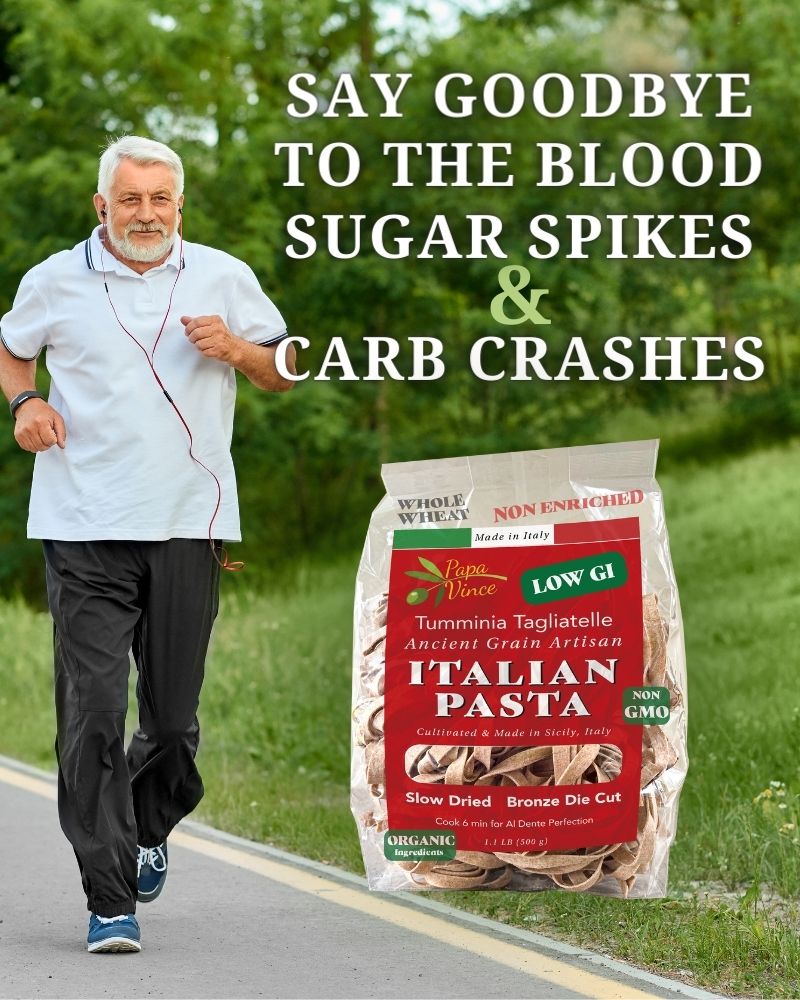
The Perfect Pasta for Diabetics!
Say goodbye to the typical sugar rush and hello to sustained, stable energy with Papa Vince’s Low Glycemic Index Pasta. Unlike conventional pasta, which rapidly converts to glucose, causing sharp spikes in blood sugar followed by sudden crashes, our pasta is meticulously crafted to prevent these fluctuations.
Crafted from high-quality Sicilian ancient grains, our pasta is made using a traditional stone-grinding process. This time-honored technique preserves the whole wheat berry’s integrity, maintaining the natural fibers and proteins. These critical components significantly slow the absorption of carbohydrates, preventing the rapid blood sugar spikes that are so common with regular pasta.
As a result, Papa Vince’s pasta provides a slow, steady release of energy. This means you enjoy a constant source of fuel, free from the disruptive peaks and troughs associated with high-glycemic foods. Our method ensures that each serving not only supports your health by minimizing blood sugar spikes but also enhances satiety, helping you feel full longer and making it an ideal part of a balanced diet.
Choose Papa Vince’s Low Glycemic Index Pasta for a meal that aligns with your wellness goals and delights your palate—perfect for maintaining consistent energy levels throughout the day, without the pitfalls of traditional pasta.
Love pasta but hate the sugar rush?
Try our low glycemic index pasta for a guilt-free meal.
Finally, a pasta that's kind to your blood sugar.

OUR FAMILY COMMITMENT
All our Pastas follow the same quality guidelines
Papa Vince Pasta
Non-GMO Ancient Grains
Heirloom Cultivation
Low Glycemic Index
High Natural Fiber content, slowing digestion
Unprocessed Cold-Stone Grinded
No Glyphosate used in farming practice
No Bleaching
Non-Enriched
Non-Fortified
No Pesticides
No Herbicides
No Insecticides
No Irrigation - Conserves Water
No Synthetic Fibers
No Synthetic Vitamins
Generic Pastas
Modern Grains
Intensive Hybridization
High Glycemic Index
Low Manufactured Fiber content, blood sugar spike
Refined and Rescontructed Wheat
With Glyphosate used in farming practice
Bleached
Enriched
Fortified
With Pesticides
With Herbicides
With Insecticides
With Irrigation
With Synthetic Fibers
With Synthetic Vitamins
ANCIENT GRAINS FOR BLOOD SUGAR CONTROL

ANCIENT GRAINS
NATURE'S LOW GLYCEMIC POWERHOUSE
Our pasta is crafted from nutrient-dense ancient wheat grains, naturally higher in fiber and protein compared to modern wheat.
These inherent properties of ancient grains slow down digestion, leading to a lower glycemic response.
By using ancient grains, we ensure that our pasta has a naturally low glycemic index, making it an ideal choice for stable blood sugar management.
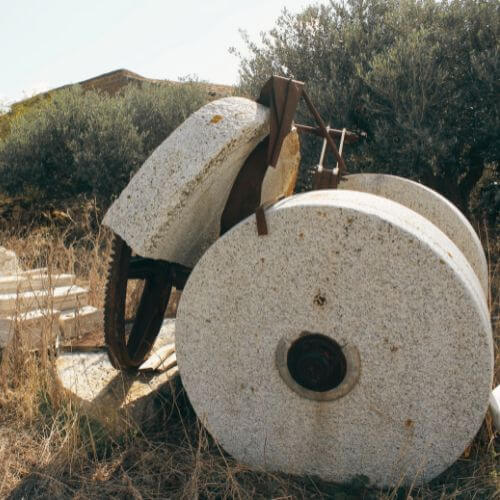
COLD-STONE GRINDING
PRESERVING LOW GLYCEMIC PROPERTIES
We use traditional cold stone grinding to turn ancient wheat grains into semolina, which is less processed than regular flour.
This gentle, slow grinding method preserves the grains' natural fiber and protein content, which are crucial for maintaining a low glycemic index.
By keeping the bran and germ intact, cold stone grinding ensures that our pasta retains its inherent low glycemic properties.
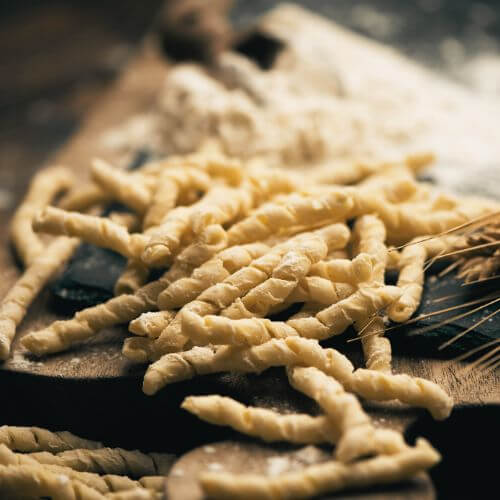
SLOW DRYING
THE FINAL STEP TO LOW GLYCEMIC PASTA
After shaping our pasta, we use a slow, low-temperature drying process.
This gradual drying helps to preserve the pasta's natural starch structure, allowing for slower digestion and a more stable glycemic response.
By taking our time in the drying process, we ensure that our pasta maintains its low glycemic index from grain to plate.
Pasta Perfection for Diabetics: Flavorful, Filling, and Blood Sugar Friendly
EAT GOOD.
Bid farewell to bland, odorless, mass-produced pasta stripped of its essence.
Say hello to the aromatic nuttiness and hearty, chewy texture of pasta crafted from ancient grains, untouched by modern technology.
Experience the gratifying chewiness and rich complexity that only stone-ground ancient grain pasta can deliver, guaranteeing not just remarkable flavor but also preserving the innate nutritional value of each grain.
UNTOUCHED BY
MODERN TECHNOLOGY
________________
FEEL GOOD.
Say goodbye to the post-meal fatigue, bloating, and sugar spikes that often come with refined, enriched pasta dishes.
Papa Vince’s pastas are made from Ancient Wheat Grains that deliver superfood levels of vitamins and minerals -all found naturally in their unprocessed state and at their optimal percentages, as nature intended.
UNPROCESSED SUPERFOOD
________________
THRIVE RAW.
Papa Vince’s Whole Grain Pasta exemplifies the 'Slow Carb' diet, a healthier carbohydrate choice that maintains stable blood sugar levels with its low glycemic index. This gradual energy release is perfect for sustained energy and effective blood sugar management.
Rich in essential nutrients, our pasta combines high fiber and protein to enhance digestion, extend fullness, and support muscle health. These key nutrients synergistically slow carbohydrate absorption, offering balanced nutrition in every meal.
STEADY ENERGY,
STABLE BLOOD SUGAR
________________
SEE WHAT OUR CUSTOMERS ARE SAYING
FAQ - Why Ancient Grain Pasta Is Ideal for Managing Blood Sugar
Does Italian pasta have a lower glycemic index than American Pasta?
Yes, traditional Italian pasta, particularly those made from ancient grains using artisanal methods, tends to have a lower glycemic index (GI) compared to industrially produced American pasta. This difference can be attributed to several key factors related to the grains used and the production processes employed.
First, many Italian pasta makers, like Papa Vince, use ancient grains such as Tumminia wheat, which are naturally higher in fiber and protein compared to modern wheat varieties commonly used in American pasta. These ancient grains' inherent properties slow digestion, leading to a lower glycemic response.
Second, artisanal Italian pasta makers often employ traditional methods such as cold stone grinding, which preserves the grains' natural fiber and protein content. This is crucial for maintaining a low glycemic index. In contrast, industrial pasta production often involves high-heat processing, which can strip away some of these beneficial components.
Furthermore, artisanal Italian pasta is typically shaped using bronze dies and slow-dried at low temperatures, which creates a rough, porous surface that allows for better sauce absorption and slower digestion. Industrial pasta, on the other hand, is often shaped with smooth Teflon dies and quickly dried at high temperatures, resulting in a less porous surface that can lead to faster digestion and a higher glycemic response.
Is there a lower glycemic index in ancient grain pasta?
Yes, ancient grain pasta inherently has a lower glycemic index (GI) compared to pasta made from modern wheat varieties.
This lower GI can be attributed to the inherent properties of ancient grains like Tumminia wheat, which naturally have a higher amylose/amylopectin ratio.
The higher amylose/amylopectin ratio in ancient grains means that they contain a greater proportion of amylose molecules, which are more resistant to digestion compared to amylopectin. This resistance results in a slower breakdown of starch during digestion, leading to a more gradual release of glucose into the bloodstream.
In contrast, modern wheat varieties used in many conventional pasta brands have a higher proportion of amylopectin, which is more readily digested and absorbed. This quick digestion can cause a rapid increase in blood sugar levels, leading to a higher glycemic response.
Because the starch in ancient grains is digested more slowly, the glycemic response is blunted, resulting in a lower glycemic index. Foods with a lower glycemic index cause a slower and more controlled increase in blood sugar levels after consumption, which is beneficial for overall health, particularly for individuals seeking to manage their blood sugar levels or improve insulin sensitivity.
Is there a pasta for diabetics?
Yes, there are pasta options that are particularly suitable for diabetics, and these options often involve a return to traditional and artisanal pasta-making methods. The rise of ultra-processed, modern pasta has led to products with a high glycemic index, which can be problematic for those managing blood sugar levels. However, by embracing traditional techniques and high-quality ingredients, it's possible to create a low glycemic index (GI) pasta that's diabetic-friendly.
At Papa Vince, we offer a pasta that's specifically crafted with diabetics in mind. Our pasta is made from whole durum Tumminia wheat semolina, an ancient grain that's naturally higher in fiber and protein compared to modern, refined wheat. These nutrients are essential for slowing down the digestion process and preventing rapid spikes in blood sugar levels.
Importantly, we adhere to traditional stone-grinding and slow-drying techniques, which help to preserve the natural fiber and nutritional integrity of the grains. Stone-grinding is a gentle, low-heat process that retains the beneficial components of the wheat, unlike modern, high-heat processing that can strip away fiber and nutrients. Similarly, slow-drying allows the pasta to maintain its natural starch structure, promoting slower digestion and a more gradual release of glucose into the bloodstream.
In contrast, highly-processed, modern pasta is often made from refined wheat that's been stripped of its fiber and nutrients. These pastas are frequently processed using high-heat methods and dried quickly at elevated temperatures, resulting in a product that's quickly digested and absorbed, leading to rapid blood sugar spikes.
By returning to artisanal methods and using wholesome, minimally processed ingredients, Papa Vince is able to offer a pasta that's not only delicious but also has a low GI and is suitable for diabetics. This type of pasta provides sustained energy and helps manage blood sugar levels, making it an excellent choice for those following a diabetic-friendly diet.
As always, it's important for individuals with diabetes to consult with a healthcare professional or registered dietitian for personalized dietary advice. However, opting for a traditionally-made, low GI pasta like Papa Vince's can be a wise choice for those looking to enjoy pasta while managing their blood sugar levels.
How does the high protein and fiber content in your pasta contribute to lower its glycemic index?
The high protein and fiber content in Papa Vince pasta contributes to its lower glycemic index, but it's not just about the mere presence of these nutrients. It's about how these nutrients are preserved and delivered within the context of the whole grain, thanks to our traditional cold stone grinding process.
Modern pasta production often involves separating the wheat grain into its constituent parts (bran, germ, and endosperm) and then recombining them in a way that attempts to mimic the original grain. However, this reconstructed approach is reductionist and fails to capture the complex synergy of nutrients found in the intact whole grain.
In contrast, our cold stone grinding process honors the sanctity of the whole wheat berry. This traditional method gently grinds the entire grain, preserving the intricate food matrix that nature designed. The bran, germ, and endosperm remain united, allowing for a harmonious interplay of nutrients that promotes slower digestion and a lower glycemic response.
The fiber in our pasta, found primarily in the bran, acts as a natural barrier that slows down the access of digestive enzymes to the starchy endosperm. This delays the breakdown and absorption of carbohydrates, resulting in a more gradual release of glucose into the bloodstream. Similarly, the proteins in the wheat, concentrated in the germ and endosperm, contribute to a slower digestion process and a feeling of prolonged satiety.
However, it's not just the presence of fiber and protein, but their natural distribution within the intact whole grain that makes the real difference. Modern pasta, with its reconstructed nature, disrupts this delicate balance and reduces the grain to a sum of its parts. This oversimplification neglects the complex interactions and synergies that occur within the whole grain matrix.
Our Tumminia wheat semolina, carefully milled using cold stone grinding, preserves this intricate matrix. The result is a pasta that boasts 11 grams (39% of the Daily Value) of dietary fiber and 8 grams of protein per serving, but more importantly, these nutrients are delivered in a way that respects the grain's natural complexity.
This is why our pasta, thanks to its traditional processing methods and the preservation of the whole grain's integrity, has a naturally lower glycemic index compared to modern, reconstructed pasta. It's a testament to the wisdom of honoring the complexity of nature's design rather than attempting to simplify it.
FAQ - Why Low GI Pasta Should Be Your New Ally
What makes low GI pasta a better choice for blood sugar management?
Low glycemic index (GI) pasta is a better choice for blood sugar management due to its ability to stabilize blood glucose levels and provide sustained energy. A low GI food means it is digested and absorbed more slowly than high GI foods, leading to a slower release of glucose into the bloodstream and a more stable blood sugar response.
Low GI pasta is often made from whole wheat, lentil, or other high-fiber and high-protein ingredients, which can contribute to its lower GI. In fact, Papa Vince Tagliatelle is made with Tumminia Ancient Grains, which contain 6 times more fiber than conventional wheat!
Beyond stabilizing blood glucose levels, a low GI diet can reduce the risk of developing type 2 diabetes and cardiovascular diseases, help manage weight by keeping you fuller longer, and improve cholesterol levels.
What role does the glycemic index play in long-term health and wellness?
The glycemic index plays a significant role in long-term health and wellness by influencing blood sugar levels, which in turn impacts various aspects of health.
Research indicates that consuming lower glycemic index diets is associated with several health benefits, including attenuated blood glucose increases, lower postprandial hypoglycemia, lower hyperlipidemia, lower insulinemia, less elevation of inflammatory markers, and less counter regulatory endocrine responses.
Moreover, elevated postprandial glycemia is linked to common chronic diseases globally, with studies showing impaired glucose tolerance associated with increased mortality, particularly from cardiovascular disease.
By understanding and managing the glycemic index of foods consumed daily, individuals can potentially reduce the risk of developing type 2 diabetes, improve cholesterol levels, and lower the risk of long-term complications associated with diabetes.
In essence, the glycemic index serves as a valuable tool in guiding dietary choices to promote stable blood sugar levels, reduce the risk of chronic diseases, and enhance overall health in the long term.
How does the fiber content in your pasta support a low glycemic response?
The fiber content in pasta supports a low glycemic response by slowing down the digestion and absorption of carbohydrates, leading to a more gradual release of glucose into the bloodstream.
This is because fiber is not easily digested, and it helps to form a gel-like substance in the stomach that slows down the digestion of other carbohydrates. This is why pasta made from whole grains or high-fiber ingredients, tend to have a lower glycemic index than pasta made from refined grains.
Additionally, pasta that is cooked al dente, or slightly firm, has a lower glycemic index than pasta that is cooked until it is soft and mushy. This is because the starch in pasta becomes more easily digestible as it is cooked, leading to a higher glycemic response.
By choosing pasta with a high fiber content and cooking it al dente, you can help to support a low glycemic response and maintain stable blood sugar levels.
FAQ - The Revival of Artisanal Italian Pasta
What's the difference between Italian and American Non-Enriched Wheat?
The difference between Italian and American non-enriched wheat largely hinges on cultivation practices and regulations regarding GMOs and pesticide use, notably glyphosate (herbicide).
Italian wheat, especially non-enriched varieties, is typically grown under stringent European regulations that favor non-GMO crops and significantly restrict the use of glyphosate and other chemicals. This approach ensures that the wheat remains as natural and untouched as possible, preserving its nutritional integrity and flavor.
In contrast, even when non-enriched, American wheat may still be produced from GMO strains and is more likely to be exposed to glyphosate and other pesticides during cultivation. These practices can raise concerns about potential health impacts and environmental sustainability. The use of glyphosate, in particular, has been a point of contention, with debates over its safety and effects on human health and the ecosystem.
Choosing Italian non-enriched wheat means opting for a product that aligns with stricter standards for GMOs and pesticide use, offering a cleaner, potentially safer ingredient for consumers who prioritize natural and environmentally friendly agricultural methods.
Why Choose Pasta Made with Ancient Grain Wheat Semolina?
Indulge in a slice of Italy with our Sicilian Ancient Grain Wheat Semolina Pasta, a nod to the timeless traditions of Italian cuisine. Celebrating the full, untouched essence of the wheat grain, our pasta is made from durum wheat semolina, known for its golden hue and rich, nutty flavor.
This choice reflects our commitment to preserving the grain's wholesome goodness and natural aroma, offering an authentic taste of Sicilian heritage in every bite.
How Do We Keep Antioxidants and Fiber Intact in Every Bite?
Our secret to preserving the wheat's soul lies in the age-old art of cold stone grinding. This traditional method keeps the natural proteins, omega-3s, antioxidants from the germ, and fiber from the bran intact, unlike modern processing techniques that can diminish these essential nutrients.
Papa Vince’s Pasta boasts an unparalleled 'al dente' texture and a perfect balance of robust, earthy tones and a subtle sweetness—thanks to our dedication to preserving these vital nutrients.
Why are Ancient Grains from Sicily the Best?
In countries like Canada, France, and the USA, the battle against fungus and mycotoxins is a significant concern for wheat cultivation, often compromising the integrity of the whole wheat berry, forcing them to use fungicides.
Did you know certain people mistake gluten sensitivity with being allergic or sensitive to fungicides?
However, Sicily stands apart in this regard, thanks to its dry and hot climate that naturally discourages fungus growth. This favorable environment allows for the preservation of the entire whole wheat berry without the worry of mycotoxin contamination.
The unique climatic conditions of Sicily provide an ideal setting for growing wheat that is both healthy and pure, ensuring that the risk of fungus-induced damage is minimized and the quality of the wheat remains uncompromised.
At Papa Vince, we Lab Test all our products to ensure no mycotoxin contamination and no fungicides are used during farming.
Why can Ancient Grains from Sicily be Cultivated without Pesticides?
Sicilian ancient grains, celebrated for their extraordinary biodiversity and resilience, flourish without the need for fertilizers, pesticides, or artificial irrigation.
Genetically akin to einkorn wheat, humanity's oldest known wheat, these grains provide a gluten-sensitive option, yielding a nutritious and digestible whole wheat berry.
Science is now uncovering the potential of these resilient grains, which have flourished under the influence of diverse cultures throughout history.
FAQ - Artisanal Traditional Pasta Making Process
Stone-Ground vs. Refined: What Difference Does It Make in Our Pasta?
Far from the stripped-down essence of refined flours, our durum wheat semolina is a testament to whole grains' integrity. By choosing not to refine our semolina, we ensure that the pasta retains the complexity of flavors and nutrients that refined counterparts often lose.
This commitment to maintaining the semolina’s natural state allows us to deliver a product that tastes better and aligns with our vision of offering healthful, nourishing food.
Why Our Pasta Grabs Sauce Better? The Bronze-Die Cut Secret
The traditional method of bronze-die-cut pasta involves extruding pasta dough through bronze dies, resulting in a rough, porous texture on the noodles. This rough texture allows sauces to adhere effectively to the pasta, enhancing the overall flavor and dining experience.
On the other hand, modern non-stick die-cut pasta, often made using Teflon-coated dies for quicker and more cost-effective pasta production, produces pasta with a smooth, almost satiny surface. While the smooth surface may look visually appealing, it does not provide the same level of sauce absorption and texture as bronze-die-cut pasta.
The rough texture of bronze-die-cut pasta allows sauces to cling better to the noodles, creating a harmonious marriage between the pasta and sauce.
Slow vs. Fast-Dried Pasta: What’s the Difference and Why it Matters?
The differences between slow, low-temperature drying pasta and rapid, high-temperature drying pasta are substantial. These differences affect the pasta's texture, flavor, nutritional value, and interaction with sauces and cooking processes.
Texture:
• Rapidly dried pasta, processed at high temperatures, often ends up denser, with a yellower appearance and a more slippery texture due to tighter protein networks and protein degradation. This alteration makes the pasta less porous and not as adept at absorbing sauces.
• In contrast, slow-dried pasta retains a tenacious, elastic texture that is neither too sticky nor too slick. This ensures even cooking and achieves the ideal 'al dente' consistency cherished in pasta dishes.
Nutritional Value:
• The rapid drying process, with its high temperatures, can diminish the pasta's nutritional content and make it harder to digest.
• On the other hand, slow drying at lower temperatures safeguards the pasta’s nutritional integrity. It protects heat-sensitive components such as B vitamins and antioxidants/polyphenols, resulting in a product that's richer in flavor and lighter on the stomach, ensuring a more balanced and digestible meal.
Cooking Properties:
• Quickly dried pasta can exhibit a rubbery texture and may not integrate as well with sauces, often bouncing rather than blending in the palate. This is partly due to the starch not fully gelatinizing into a smooth paste.
• Conversely, pasta that is slow-dried dissolves more readily into a creamy consistency when cooked and combined with sauces, enhancing the overall culinary experience with a lush texture that perfectly complements its condiments.
In essence, while rapid drying can compromise pasta quality across various aspects, slow drying meticulously preserves the pasta's inherent qualities. This method ensures a superior texture, richer nutritional profile, and a more enjoyable eating experience, solidifying slow-dried pasta's position as the preferred choice for those seeking the authentic essence of pasta cuisine.
Can Switching to Ancient Grains Improve Your Dietary Habits?
Unlike modern wheat, which has been selectively bred for higher gluten strength and yield, ancient grains offer a gluten quality that is inherently less inflammatory and more digestible.
This makes them a superior choice for those looking to improve their dietary habits. Modern grain hybridization and gene alteration have primarily affected wheat's protein content, resulting in ancient grains having a weaker gluten index in their more naturally occurring form.
Additionally, the protein content is why ancient grain pasta, made in the traditional way, preserves superfood levels of nutrition in terms of vitamins and minerals.
What Nutritional Edge Do Ancient Grains Hold Over Modern Ones?
Ancient grains hold a significant nutritional edge over modern ones.
They are not just about lower gluten toxicity; they are nutritional powerhouses enriched with antioxidants, vitamins, minerals, and micronutrients.
Research underscores the benefits of ancient grains for their digestible gluten and reduced levels of immunogenic proteins, which contribute to decreased inflammation and improved tolerance for gluten-related disorders.
Furthermore, the elevated presence of secondary metabolites and polyphenols in ancient grains enhances their metabolic and clinical benefits, underscoring their nutritional superiority.
Why Are Natural Proteins and Omega-3s More Potent in Our Pasta?
Our pasta's standout nutritional profile, featuring highly potent natural proteins and omega-3s, stems from our commitment to the age-old technique of cold stone grinding.
This artisanal process is the cornerstone of our approach, ensuring the wheat's vital nutrients—natural proteins, omega-3 fatty acids, antioxidants, and fiber—are preserved in their most wholesome form.
Unlike modern processing methods, which often strip away these essential nutrients, our traditional grinding technique safeguards the wheat's nutritional integrity.
This meticulous process preserves our pasta's dense nutritional content and imbues it with an unparalleled 'al dente' texture and a harmonious blend of robust, earthy flavors complemented by a hint of subtle sweetness.
At Papa Vince, we believe in honoring the wheat's soul by retaining its healthful essence, offering you a pasta experience that is not only delicious but deeply nourishing.

Over 50,000+ Happy Customers





All the A’s to your Q’s about Our Low Glycemic Index Pasta
What is the Glycemic Index?
The glycemic index (GI) is a ranking system used to classify foods based on their effect on blood sugar levels. It is measured by comparing the blood sugar response to a food containing 50 grams of carbohydrates to the response to a reference food, typically pure glucose, also containing 50 grams of carbohydrates.
Foods with a low GI value are slowly digested and absorbed, producing only small fluctuations in blood glucose and insulin levels. By contrast, high GI foods are rapidly digested and absorbed, producing a more pronounced fluctuation in blood glucose levels.
Whole grains tend to have lower GI values than processed grains because whole grains contain more fiber and minerals that slow down digestion.
A low GI diet has several health benefits, including reduced insulin levels and insulin resistance, increased HDL cholesterol and reduced LDL cholesterol, protection against cardiovascular disease by reducing inflammation, reduced risk of some cancers by reducing insulin levels, and lower abdominal fat due to increased insulin sensitivity, which allows for more efficient processing of carbohydrates and fat burning as a fuel source.
What is Diabetes?
Diabetes is a chronic health condition that affects how the body turns food into energy. It occurs when the blood glucose, also known as blood sugar, is too high.
Glucose is the body's main source of energy, and when blood sugar levels rise, it signals the pancreas to release insulin. Insulin acts as a key to allow blood sugar into the body's cells for energy. In diabetes, the body either doesn't produce enough insulin or can't use it effectively, leading to elevated blood sugar levels.
Over time, high blood sugar can cause serious health problems such as heart disease, vision loss, and kidney disease.
There are three main types of diabetes:
• Type 1 diabetes is characterized by the body's inability to produce insulin.
• Type 2 diabetes involves the body's cells not using insulin properly.
• Gestational diabetes occurs during pregnancy and usually goes away after childbirth but increases the risk of developing type 2 diabetes later in life.
Prediabetes is a condition where blood sugar levels are higher than normal but not high enough for a diabetes diagnosis, increasing the risk of developing type 2 diabetes.
Overall, diabetes is a common condition that affects people of all ages and can be managed through medications, lifestyle changes, and proper healthcare.
What is Diabetes?
Insulin sensitivity refers to how responsive your cells are to insulin. When your insulin sensitivity is low, it puts pressure on your pancreas to increase insulin production to clear sugar from your blood.
Low insulin sensitivity is also called insulin resistance. Insulin resistance can result in chronically high blood sugar levels, which are thought to increase your risk of many diseases, including diabetes and heart disease.
Insulin resistance is a complex condition in which your body does not respond as it should to insulin, a hormone your pancreas makes essential for regulating blood sugar levels. It can be temporary or chronic and is treatable in some cases. Insulin resistance happens when cells in your muscles, fat, and liver don’t respond as they should to insulin, leading to elevated blood glucose levels (hyperglycemia), which, over time, leads to prediabetes and Type 2 diabetes.
What is a Sugar Rush?
A Sugar Rush refers to a sudden burst of energy or hyperactivity that can occur after consuming foods high in sugar or simple carbohydrates. This term is often used to describe the rapid increase in blood sugar levels and subsequent energy boost that can follow the consumption of sugary foods.
The spike in blood sugar is typically followed by a crash, leading to feelings of fatigue or lethargy. Sugar Rush can also refer to various entertainment shows, dessert shops, and clothing lines that use the term in their branding.
What is a “Slow Carb”?
A "slow carb" refers to complex carbohydrates (carbohydrates that contain fiber and starch, which are important for digestive health, regulating blood sugar levels, and providing lasting energy) that take longer to digest, as opposed to simple carbohydrates that move through the body at a faster pace.
The slow-carb diet is a flexible eating strategy that focuses on restricting carbs and other foods for six days of the week, with one day off to eat whatever you want.
The diet is based on five main food groups: animal protein, vegetables, legumes, fats, and spices. Foods to avoid include fruits, starchy vegetables, grains, dairy, fried food, dessert, sugary beverages, and alcohol.
The diet is not a one-size-fits-all approach; it is encouraged to find nourishing foods that work for you and your lifestyle.
Is diabetes the same as Insulin Sensitivity?
No, diabetes is not the same as insulin sensitivity.
Diabetes is a disorder in the way the body uses glucose, leading to high blood sugar levels, while insulin sensitivity refers to how responsive your cells are to insulin.
Insulin sensitivity is the ability of cells to absorb blood sugar with less insulin needed effectively. In contrast, diabetes involves issues with blood sugar regulation due to either insufficient insulin production or ineffective use of insulin by the body's cells.
Is this pasta sugar-free?
Yes, in terms of added sugar: Papa Vince pasta is free from any added sugars. It is made from only two simple ingredients: ancient grain Tumminia wheat semolina and water. This means we do not add any extra sugar during the manufacturing process, keeping it as natural as possible.
No, considering natural sugars: While our pasta does not have added sugars, it naturally contains sugars that are intrinsic to the wheat used in its production. In the nutritional content of Papa Vince pasta, you'll find that it provides 39 grams of carbohydrates per serving, of which 2 grams are naturally occurring sugars. These sugars are part of the whole grains and are not added externally.
So: Papa Vince pasta does not contain any added sugars, but like all wheat products, it includes natural sugars from the grains. This is an important distinction for anyone monitoring sugar intake for dietary reasons.
Does this pasta contain fiber and protein?
Yes, it is rich in both: Papa Vince Pasta is an excellent choice for anyone, including diabetics, looking to maintain balanced blood sugar levels. Our pasta is made from Tumminia whole wheat semolina, an ancient grain celebrated for its nutritional richness.
High in Fiber: Tumminia wheat, the star ingredient in our pasta, boasts a remarkable fiber content—six times more than conventional wheat varieties. Each serving of Papa Vince Pasta delivers 11 grams of dietary fiber, 39% of the daily value (DV). This high fiber content is crucial as it helps slow the digestive process, gradually releasing sugars into the bloodstream. This slow digestion ensures that there are no sudden spikes in blood sugar levels, providing a stable energy source for a longer period.
Rich in Protein: Our pasta also provides a good source of protein, with 8 grams per serving. Protein is essential for building and repairing tissues and also plays a role in slowing digestion. The presence of protein in our pasta further aids in moderating blood sugar rises after meals.
Whole Grain: We use unbleached, non-enriched Tumminia wheat semolina, ensuring that our pasta is made from whole grains that retain all their natural nutrients. Unlike refined grains, our whole grains keep their bran and germ, delivering more fiber, protein, and other essential nutrients.
In conclusion, Papa Vince Pasta is not just a tasty meal option but also a smart choice for health-conscious individuals. Its high fiber and protein content make it particularly suitable for those managing blood sugar levels, offering a nutritious meal that supports steady energy throughout the day and making it a perfect pasta for diabetics.
How does your pasta help avoid after-meal lethargy?
At Papa Vince, we utilize a cold-stone grinding process and slowly dry our pasta at low temperatures. These key techniques help preserve the whole food matrix, including the original starch structure of the Tumminia wheat.
This preservation ensures that all parts of the wheat berry—the bran, germ, and endosperm—remain intact. Such a comprehensive preservation strategy means that our pasta is digested more slowly than typically refined pastas.
Slow digestion is crucial because it leads to a gradual release of glucose into the bloodstream rather than a rapid spike. This steadier sugar release prevents the sharp peaks and troughs in blood sugar levels often followed by the after-meal lethargy associated with eating refined carbohydrates.
By maintaining more consistent energy levels, our pasta helps you avoid the sluggishness that can come after consuming meals high in quickly-digested carbs.
Is Whole Wheat Pasta less processed?
In the US, whole wheat pasta is not necessarily less processed due to the common practice of adding back nutrients that were stripped away during the processing phase.
Often, what is marketed as "whole wheat" pasta might better be described as "reconstructed whole wheat." This means that the germ and bran, integral components of the wheat grain that are removed during initial processing, are later reintroduced as isolated ingredients.
This process differs significantly from traditional, artisanal methods, where the whole grain—with all its parts intact—is preserved throughout the entire production, ensuring a less processed final product.
This traditional, artisanal approach not only maintains the nutritional integrity of the pasta but also aligns more closely with what consumers might expect from a product labeled as “whole wheat”.
Why is pasta healthier in Italy than in America?
Pasta is often considered healthier in Italy than in America due to differences in ingredients and processing.
Authentic Italian pasta is made using whole grains and avoids enrichment or fortification, which helps to retain the natural nutrients of the wheat. Papa Vince's pasta is an example of going back to artisanal, traditional methods. Moreover, employing traditional Italian pasta-making techniques, such as slow drying at low temperatures, helps preserve the nutritional value and flavor of the pasta.
In the United States, there's a pronounced lean towards Big Food's modern, industrial methods in pasta production. American pasta is often crafted from refined flour, subjected to high-temperature drying in industrial settings, and commonly enriched with vitamins and minerals. This approach significantly alters the pasta's natural nutritional profile, distancing it from the traditional, artisanal practices that prioritize the preservation of inherent nutrients.
So, to determine the nutritional quality of pasta, regardless of its origin, it's essential to check the ingredient list for keywords like "enriched flour" or "enriched semolina" and look for products that maintain the grain's natural nutrient profile.
How can you tell pasta is high quality?
Judging the quality of pasta can be tricky, but there are a few key pointers you can use:
Appearance:
• Color: High-quality durum wheat pasta will have a slightly off-white or light yellow color, not an intense yellow. An intense yellow color often indicates the use of lower-quality wheat or added coloring.
• Texture: The pasta should look smooth but not overly polished. A slightly rough texture suggests the bran wasn't completely removed, indicating whole wheat or high-quality semolina.
• Shape: Look for consistent shapes without breaks, cracks, or deformities.
Ingredients:
• First Ingredient: The first ingredient listed should be "durum wheat semolina" or "whole wheat durum semolina." Avoid pasta with refined wheat flour as the first ingredient.
• Enrichment: This depends on your preference. Non-enriched pasta retains its natural nutrient profile, while enriched pasta has added vitamins and minerals.
• Additives: Avoid pasta with unnecessary additives like artificial colors, flavors, or preservatives.
Cooking & Texture:
• Cooking time: High-quality pasta usually cooks slightly longer than lower-quality varieties due to its denser texture.
• Texture after cooking: The pasta should be firm to the bite ("al dente"), not mushy or sticky. It should hold its shape well and not release excessive starch into the cooking water.
• Taste: High-quality pasta should have a slightly nutty or sweet flavor characteristic of durum wheat. It shouldn't taste bland or powdery.
What's the best way to cook your pasta for a perfect 'al dente'?
To achieve the perfect ‘al dente’ texture with our pasta, follow these steps:
1. Bring water to a rolling boil.
2. Once boiling, add sea salt. It's important to wait until the water is boiling; adding salt earlier can affect the boiling point and timing.
3. Add the pasta to the boiling water.
4. As the water returns to a boil, begin checking the pasta for your preferred texture. For that ideal 'al dente' quality, aim for a balance between softness and a slight crunch.
5. Taste the pasta and adjust the salt to your liking.
6. Once it reaches your desired 'al dente' texture, briefly introduce cool water to the pot. This stops the cooking process immediately, ensuring your pasta doesn't overcook.
7. Drain the pasta and serve it with your sauce of choice or use it as the base for a delightful pasta salad.
What differentiates your pasta from other brands?
Our pasta is crafted from ancient durum whole wheat, cold stone ground, and processed using traditional Sicilian methods, ensuring a nutrient-rich, non-GMO product without bleaching or enrichment.
JOIN THE CLUB
Become one of the the Papa Vince Family
Enter your email address below to receive exclusive updates & deals.
We will never share your information or spam you, we promise!

